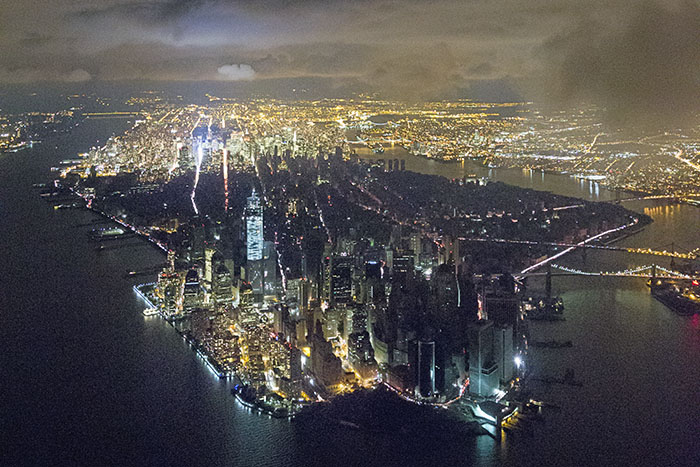'Image Building' Chronicles Architectural Photography at Parrish Museum

“Photography is not about the thing photographed. It’s about how that thing looks photographed.”
– Gary Winogrand
It is with the above quote, fittingly, that the Parrish Museum’s newest exhibition, Image Building: How Photography Transforms Architecture, opens. All told, Image Building—organized thematically into “Cityscapes,” “Domestic Spaces” and “Public Spaces”—features 57 photographs by 21 renowned, under-recognized and emerging artists. There are also several pieces of ephemera such as magazines and books that illustrate how the meaning of a photograph shifts when presented in a new context.
The photos, all from the 1930s to the present, examine the relationship between historical and contemporary approaches while, at times, presenting views of the same building by different photographers in different eras. This juxtaposition creates a dialogue between past and present, revealing the way photography shapes the perception of architecture, and how that perception changes over time. Take, for example, the photographs of Rockefeller Center: The first, “New York City Views, RCA Building Floodlighted,” by Samuel Gottscho and the second, “Rockefeller Center,” by Hiroshi Sugimoto from 2001.

In her essay included in the exhibition catalog (available at the museum shop), Dr. Therese Lichtenstein, curator of the show, notes that Gottscho’s image is full of “wonder and exhilaration, celebrating the power of new building technologies and the ‘heroic materialism’ of the modern city.” It was taken in 1933, when, despite the Depression, “American optimism coexisted with economic struggle, when Hollywood fantasy offered hope and temporary escape from bleak everyday reality,” according to Lichtenstein.
In short, Gottscho’s photograph showed the innovation, grit, determination and optimism of 1930s America. Sugimoto’s photograph meanwhile, was taken 68 years later and 40 years after Gottscho’s death. America, and the world around it, was a much-changed place since the days of the Depression. Lichtenstein notes, “in Sugimoto’s hauntingly blurry but recognizable images, solid architecture seems weightless, as though made of light and shadow.”
Sugimoto himself described the series of which “Rockefeller Center” was a part as “architecture after the end of the world.” A museum-goer should also consider the photographs of Notre Dame du Haut by Ezra Strollers, taken in 1955, and by Sugimoto, taken in 1998.

Of more immediate interest to East Enders and summer visitors might be the stunning photography of New York City. Berenice Abbot’s “Changing New York; Columbus Circle” from 1936 shows the place in an era almost unrecognizable to a modern viewer while making it feel completely alive—as if we might hop on the trolley and take it down 8th Avenue. Further juxtaposition is created by Abbot’s “Night View,” an almost-abstract nighttime aerial photo of New York, in which the buildings are illuminated by their lights, and Iwan Bann’s “The City and the Storm,” another aerial view of the city, but this one taken after Hurricane Sandy left much of Manhattan in a black out.
While any person with even a passing interest in art, photography, or architecture can certainly enjoy Image Building, it is writers and painters who might benefit most from this exhibition, which contains neither painting nor writing. Returning to Winogrand’s quotation, the same can be said about painting and writing. One cannot simply tell a story and call it a novel. And even the most uncreative person can turn a clever phrase or write an interesting sentence—just take a look at Twitter and its most infamous user. Indeed, a novel is not about the story, but how the story is told. As for painters, consider that just about anyone can drip paint on a canvas—even your five-year-old—but as Pollock said, “technique is just a means of arriving at a statement.”

The following programs, related to the exhibition, are part of Parrish’s Friday Nights program:
On Friday, April 6 at 6 p.m. join a conversation with artist and photographer James Casebere, featured in “Image Building,” about how photography can change the way we look at architecture. Parrish director Terrie Sultan will moderate.
On Saturday, Arpil 14 at 5 p.m. Iwan Baan, one of the most sought-after photographers today, will talk with William Menking, Founder and Editor-in-Chief of “The Architect’s Newspaper,” about how a photographer’s aesthetic choices and use of technology can imbue seemingly static buildings with feeling and meaning.
On Friday, April 20 at 6 p.m. join a conversation in the exhibition gallery with architect Lee H. Skolnick, photographer Ralph Gibson and guest curator Dr. Therese Lichtenstein about movement, memory, and the peripheral vision in architectural photography.
On Friday, June 1 at 6 p.m. explore the life of Finnish-American modernist architectural giant Eero Saarinen (1910-1961), whose visionary buildings include National Historic Landmarks such as St. Louis’ iconic Gateway Arch and the General Motors Technical Center in Michigan, with a screening of “American Masters—Eero Saarinen: The Architect Who Saw the Future,” co-presented with HT2FF.
Image Building is on display through June 17 at the Parrish Art Museum, 279 Montauk Highway, Water Mill. 631-283-2118, parrishart.org.



